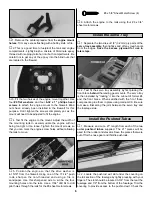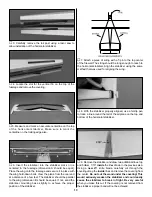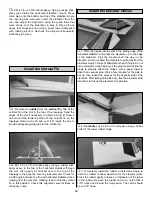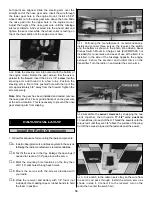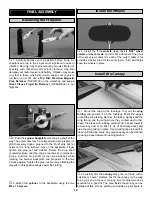
suit your own personal tastes. Roughen the bottom 1/8" of
the canopy edge, as well as the area on the wing fairing that
the canopy contacts. Be careful not to scratch any areas that
may be visible when the canopy is installed. Glue the
canopy in position with 6-minute epoxy or RC-56 glue. Finish
the canopy by painting the frame lines using fuelproof paint
or striping tape.
Note
: Always test your paint on a small sample of the
canopy to make sure that it doesn’t attack or deform the
the canopy material.
Note:
This section is
VERY IMPORTANT
and must
NOT
be omitted! A model that is not properly balanced will be
unstable and possibly unflyable.
❏
1. Accurately mark the balance point on the
bottom
of the
wing on both sides of the fuselage. The balance point is
located
4-1/8" back from the leading edge
. This is the
balance point at which your model should be balanced for
your first flights. Later, you may wish to experiment by shifting
up to
1/4" forward or aft
to change the flight characteristics.
Moving the balance
forward
may improve the smoothness
and arrow-like tracking, but it may then require more speed
for takeoff and make it more difficult to slow down for landing.
Moving the balance point
aft
makes the model more agile
with a lighter and snappier “feel” and often improves knife
edge capabilities. In any case,
please start at the location
we recommend and do not at any time balance your
model outside the recommended range
.
❏
2. With the wing attached to the fuselage, all parts of the
model installed (ready to fly) and an
empty
fuel tank, hold the
model at the marked balance point with the stabilizer level.
❏
3. Lift the model. If the tail drops when you lift, the
model is “tail heavy” and you must add weight* to the nose.
If the nose drops, it is “nose heavy” and you must add
weight* to the tail to balance.
Note
: Nose weight may be added by using a Heavy Spinner
nut (1/4"-28 GPMQ4640)(5/16"-24 GPMQ4641) or by gluing
weights to the firewall. Tail weight may be added by using
Great Planes (GPMQ4485) “stick-on” lead weights. Later, if
the balance proves to be O.K., you can open the bottom of
the fuse and glue these permanently in position.
*If possible, first attempt to balance the model by changing
the position of the receiver battery and receiver. If you are
unable to obtain good balance by doing so, then it will be
necessary to add weight to the nose or tail to achieve the
proper balance point.
4-1/8"
Balance Your Model
Note
: Throws are measures at the widest part of the
elevators, rudder and ailerons.
We recommend the following control surface throws:
High rates
Low rates
ELEVATOR
1/2" UP
3/8" UP
1/2" DOWN
3/8" DOWN
RUDDER
1-1/4" RIGHT
1" RIGHT
1-1/4" LEFT
1" LEFT
AILERONS
7/16" UP
5/16" UP
7/16" DOWN
5/16" DOWN
CARBURETOR WIDE OPEN
NOSE WHEEL TURNS RIGHT
RUDDER MOVES RIGHT
LEFT AILERON MOVES DOWN
RIGHT AILERON MOVES UP
ELEVATOR MOVES UP
4-CHANNEL
TRANSMITTER
(STANDARD MODE 2)
4-CHANNEL RADIO SETUP
TRANSMITTER
4-CHANNEL
TRANSMITTER
4-CHANNEL
TRANSMITTER
4-CHANNEL
Control Surface Throws
20



